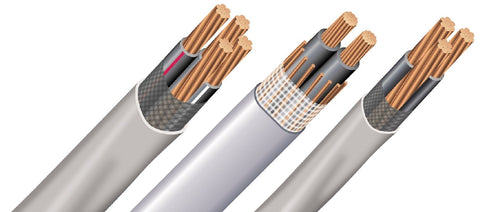SER vs. SEU: The Pitfalls and Secrets of Service Entrance Cables
What Is a Service Entrance Cable?

Updated October 2025
Service Entrance (SE) cables are electrical cables that deliver power from utility companies to residential buildings. As defined by the National Electric Code (NEC) in Article 230, these cables are specifically designed for service entrance applications—meaning they connect the power source to the main electrical panel of a building.
There are two main types of SE cables: SER (Service Entrance Round) and SEU (Service Entrance Unarmored). Both are rated for 600 volts and can be installed in dry or damp locations. These cables are flame-retardant and moisture-resistant. Depending on the specific product, the conductors may be insulated with RHW, RHW-2, XHHW, XHHW-2, THWN, or THWN-2.
SER vs SEU: What Do These Abbreviations Mean?
One common pain point for customers shopping for service entrance cables is confusion about what SER and SEU actually stand for. Misinformation online often blurs the line between the two, but the differences are clear once explained correctly.
-
SER Cable (Service Entrance, Round)
SER is a round cable that typically includes two or three insulated phase conductors, one insulated neutral, and one bare ground. It's used above ground for panel feeders and branch circuits, both in residential and light commercial settings. Its construction makes it suitable for wiring after the main service disconnect. -
SEU Cable (Service Entrance, Unarmored)
SEU is a flat, oval-shaped cable with two-phase conductors and a concentric neutral. It lacks a dedicated ground wire, as the neutral serves both functions up to the service disconnect. SEU cables are often used to connect a meter base to the main panel in homes.
Important: SEU is sometimes mislabeled online as an "underground service entrance cable." This is incorrect—neither SER nor SEU is suitable for underground installation. For direct burial, you need USE (Underground Service Entrance) cable.

Key Differences in Application: SER vs SEU
While both cables can be used for feeders and branch circuits, their internal construction defines where and how they should be installed.
SER cable has a bare ground conductor in addition to the neutral, which makes it suitable for use after the main service disconnect. It is commonly installed to feed distribution panels throughout residential buildings, including subpanels located in different parts of the home or in detached structures.
SEU cable, on the other hand, has a concentric neutral but no ground. This limits its use to up to the main service disconnect, where the neutral and ground are still bonded. A typical application is running power from the meter base to the main electrical panel in homes.
The NEC requires the separation of neutral and ground conductors beyond the main disconnect, which is why SEU should not be used to feed subpanels.

Installing Service Entrance Cables: What You Should Know
Although installation should be handled by a licensed electrician, here’s a general overview of what’s involved:
For SER cables, the bare neutral must be secured at both ends—at the utility pole and the service entrance point.
Use an insulator and an archer bolt to attach it properly.
After mounting, the neutral and two hot conductors are spliced and pulled through a protective weatherproof fitting called a "waterhead".
A 36-inch drip loop is essential to keep water from entering the system—failing to include this can cause corrosion or shorts.
Modern Use of SER and SEU (as of 2025)
In modern electrical installations as of 2025, the use of SER and SEU cables continues but with some noticeable shifts in practice. Although both cable types are still approved under NEC Article 338, many electricians now also consider running individual conductors—such as THHN, THWN‑2, or XHHW‑2—through conduit. This approach is gaining traction in new construction and commercial projects where longer, more complex runs are common. Running individual wires in conduit allows for better airflow and heat dissipation, reduces the risk of physical damage, and makes it easier to replace or upgrade conductors over time. It also gives electricians more flexibility in navigating structural obstacles and maintaining clean, code-compliant routes.
However, SER cable remains widely used and preferred in most residential applications. Its round shape, including ground conductor, and code-compliant construction make it a practical choice for above-ground feeders that run between the main panel and distribution panels throughout the home. It is often the first choice for residential electricians working on single-family homes, multi-unit dwellings, and detached buildings like garages or workshops.
SEU cable, on the other hand, is now used more selectively. Because it lacks a separate ground conductor, its use is limited to the portion of the system between the utility meter and the main panel, where the neutral and ground are still bonded. While it is still installed in service entrance runs for residential buildings, SEU is generally being phased out in favor of SER or conduit-based wiring in cases where future panel expansion or feeder routing may be needed. Still, newer versions of both SER and SEU cables often feature compact 8000‑series aluminum conductors and updated insulation like XHHW‑2 or THWN‑2, providing better flame resistance, moisture protection, and long-term performance for modern electrical systems.
Choosing a Service Entrance Cable
Now that you know all the basics about SER and SEU cables, the last step is to choose the cable that works for your particular electrical project. At Nassau National Cable, we sell service entrance cables with aluminum and copper conductors. Aluminum service entrance cables are cheaper, lighter, and generally easier to install, whereas copper cables are more durable with superior electric conductivity. Both aluminum and copper electrical cables are of excellent quality, so the choice boils down essentially to the priorities of your particular electrical project. Visit our website to learn more about SEU and SER service entrance cables. Some of the most common service entrance cables we sell are Aluminum SER Service Entrance Type R Cable, Aluminum SEU cable, Copper SER Cable, and Copper SEU cable.
























